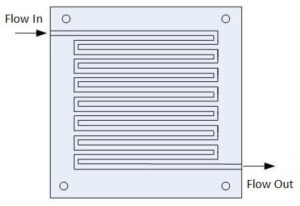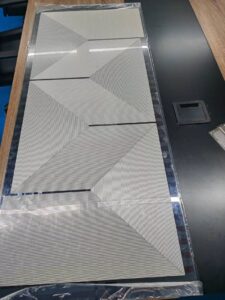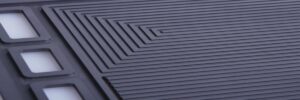There’s an aspect of fuel cell technology that doesn’t usually get much attention but is important: the flow field design on the bipolar plates . They aren’t only fanciful patterns on metal; instead, they direct fuel, oxygen, and coolant to the necessary places. With a good fit, your fuel cell could sound like music. If the installation isn’t right, your vehicle will run poorly, overheat or even experience flooding. In this article, we will discuss three basic types of bipolar flow channel design for fuel cell.
What do flow fields mean?
The main idea of a flow field is the grooves created on a bipolar plate by anodic and cathodic film growth. Using these channels, hydrogen and oxygen reactants, the cooling system and water produced can be moved within the fuel cell. The process is central to what makes the EU successful.
- Distributing fuel and oxidants within air.
- Managing heat.
- Researchers remove water that is already created in the reactions.
The flow field serves as a traffic control for fuel cells in a stack.

Types of Bipolar Flow Channel Design
Over time, engineers have explored various ideas to find the optimal balance between the monthly gas flow, pressure loss, heat generated, and overall utilisation. Let’s focus on the top several of these.
Straight Flow Channels
Design and Function
Imagine lots of straight lines placed across a metal plate so they are parallel to each other. You have what’s known as the straight flow channel design . This form is the most straightforward and also the easiest to make.
Advantages
- A weak current distribution within the plate.
- A low pressure drop helps to lower the amount of energy you use.
- The fabrication process is made simple and affordable by relying on geometry.
Disadvantages
- A fast stay of gases in the converters leads to decreased use of resources.
- After it forms, water may collect to result in flooding.
- Less mixed air flow than in the case of other designs.
Cross-Sectional Shapes Matter
Research finds that the form of firearm channels can influence how well they work. For example:
- Rectangular: Reliable balance, used often.
- Trapezoidal: With this geometry, current density becomes more balanced.
- Circular or triangular : You don’t see these shapes often and it’s more complicated to make them.
Variable Cross-Section Flow Channels
Flow channels whose shape can vary from place to place. Certain researchers even twisted it up by trying something different. If the channel’s shape is adapted along the flow, this:
- Improve the movement of mass in the tissue.
- Raise the stirring which boosts the number of chemical reactions taking place.
- Improve the level of current output for a given physical space.
Serpentine Flow Channels
Single-Channel Serpentine
The shape of the design makes it difficult for the gas to travel quickly. Imagine a garden hose going back and forth.
Pros:
- Your home will stay dry with excellent water removal.
- Prevents the gas from sticking in one place.
Cons:
- The longer the piping system, the greater the pressure loss is.
- If there are obstacles on the path? You’re not in luck. A cell as a whole may fail.
Multi-Channel Serpentine
So that trees wouldn’t entirely block the flow, engineers increased the number of channels. This version which mixes styles.
- Keep pressure manageable.
- Improve gas distributions.
- Cuts down the risk of blockage.
Gradual Multi-Channel Flow
Even fancier? A number of designs gradually reduce the number of channels as water flows from the inlet to the outlet. This helps:
- Safeguard the water system better.
- Keep the flow rates the same throughout production.

Interdigital Flow Channels
Flow channels aren’t uninterrupted, and the gaps often make gas divert. Pass from the GDL to get to different paths. Connect more closely with the topics in the catalyst layer.
Benefits:
- Makes more gas move up from below into the layer that we use.
- It supports efficient use of less space.
- Makes it possible to dry faster using forceful convection.
Drawbacks:
- Low pressure is being reported.
- The GDL may be damaged when swimming speed increases too much.
Innovative and Emerging Flow Field Designs
People in fuel cell research never take a break. Designers are now coming up with concepts that are smashing traditions.
- Nature-inspired geometries.
- 3D printing methods.
- Optimization using results from computational fluid dynamics (CFD) calculations.
We’ll look at the leading options.
Bionic Flow Fields
Bionic flow fields resemble the ways that natural systems are designed.
- Leaf veins.
- Lung airways.
- Blood vessels.
They:
- Try to create an equal spread of gas throughout your home.
- Enhance ways to move people quickly across large populations.
- Remove water faster with a better result.
Spiral and 3D Flow Fields
These designs look wild but work amazingly. Generated spiral flow fields bring about circular movement and more efficient dissipation of heat. With 3D mesh/grid fields, gas is allowed to move freely in every direction.
Is this a case of note? The cathode plate in the 2014 fuel cell vehicle from the carmaker was made with a 3D fine-grid structure. Benefits included:
- There was no single gas route—the flow was very flexible.
- Strong ability to discharge water.
- Exposing the catalyst layer more than in the original system.
Cross-Sectional Geometry and the Effects It Has
The form of a channel’s cross-section matters not only for appearance but also because it manages:
- Flow rate.
- Current density.
- Reaction area.
Comparing Shapes:
- Under high loads, each square foot of a cell transfers more electrical current than before.
- In a trapezoidal reactor, even gas distribution is common.
- Dovetail : At the bottom when it comes to performance among them all.
Wave-Shaped and Variable Cross-Section Designs
Designs in which the shape and size of the pipe change with its length. If you alter the cross-section at any point along the member, it is called:
- Create turbulence.
- Better mix the gas.
- Maximize the ways you use catalysts.
How fluid dynamics works in complex flow situations
Dean Vortices and S-Shaped Channels
Vortex forms at the vanes and gives way to S-shaped channels as the aerodynamic model evolves.
Dean vortices develop along curved sections in a wing’s surface. These are small whirlpools discovered in:
- Improve mixing.
- Enhance the process by which heat moves.
- Improve overall how your business works.

Water Mixing at Intersections
When streams meet at a channel intersection, the two streams often mix in S-shaped designs. As a result, people:
- Better coolant effectiveness.
- More uniform temperature throughout the fuel cell
Performance Comparison Between Types of Bipolar Flow channel Design
Here’s how the different designs stack up:
| Flow Type | Gas Utilization | Water Removal | Pressure Drop | Complexity |
|---|---|---|---|---|
| Serpentine | High | High | High | Moderate |
| Interdigital | Very High | Very High | Very High | Complex |
| Bionic/3D | Excellent | Excellent | Medium-High | Advanced |
Design Challenges and Trade-Offs
You can’t have it all. An important part of an engineer’s job is to keep a balance between:
- Performance vs. pressure drop.
- Water management vs. gas diffusion.
- Ease of manufacture vs. design complexity.
The type of materials used can be very important. Flexible thin plates deform easily, but thick ones decrease the power produced per unit area.
Conclusion
Bipolar flow channels are crucial to fuel cell performance and go beyond simple design functions. The possibility of using straight lines or spirals creates new benefits and disadvantages with every design. How fuel is transported can make all the difference between a successful and a failing fuel cell
FAQs
What’s the most efficient flow channel for PEM fuel cells?
The interdigital and 3D flow fields offer the best performance, but at the cost of higher pressure loss and complexity.
Why are 3D flow fields considered innovative?
They allow gas to move in all directions, improve water removal, and expose more catalyst area, boosting power output.
How do flow field designs affect flooding in fuel cells?
Poor designs trap water, blocking gas paths. Good designs (like serpentine or 3D) remove water quickly to prevent flooding.
What materials are ideal for complex flow channel fabrication?
Stainless steel (like SS316L) is common, especially when paired with precision laser cutting or etching technologies.
Can flow field design influence the overall fuel cell lifespan?
Absolutely. Better flow means lower heat stress , fewer clogs , and less corrosion , all of which extend the fuel cell’s life.

